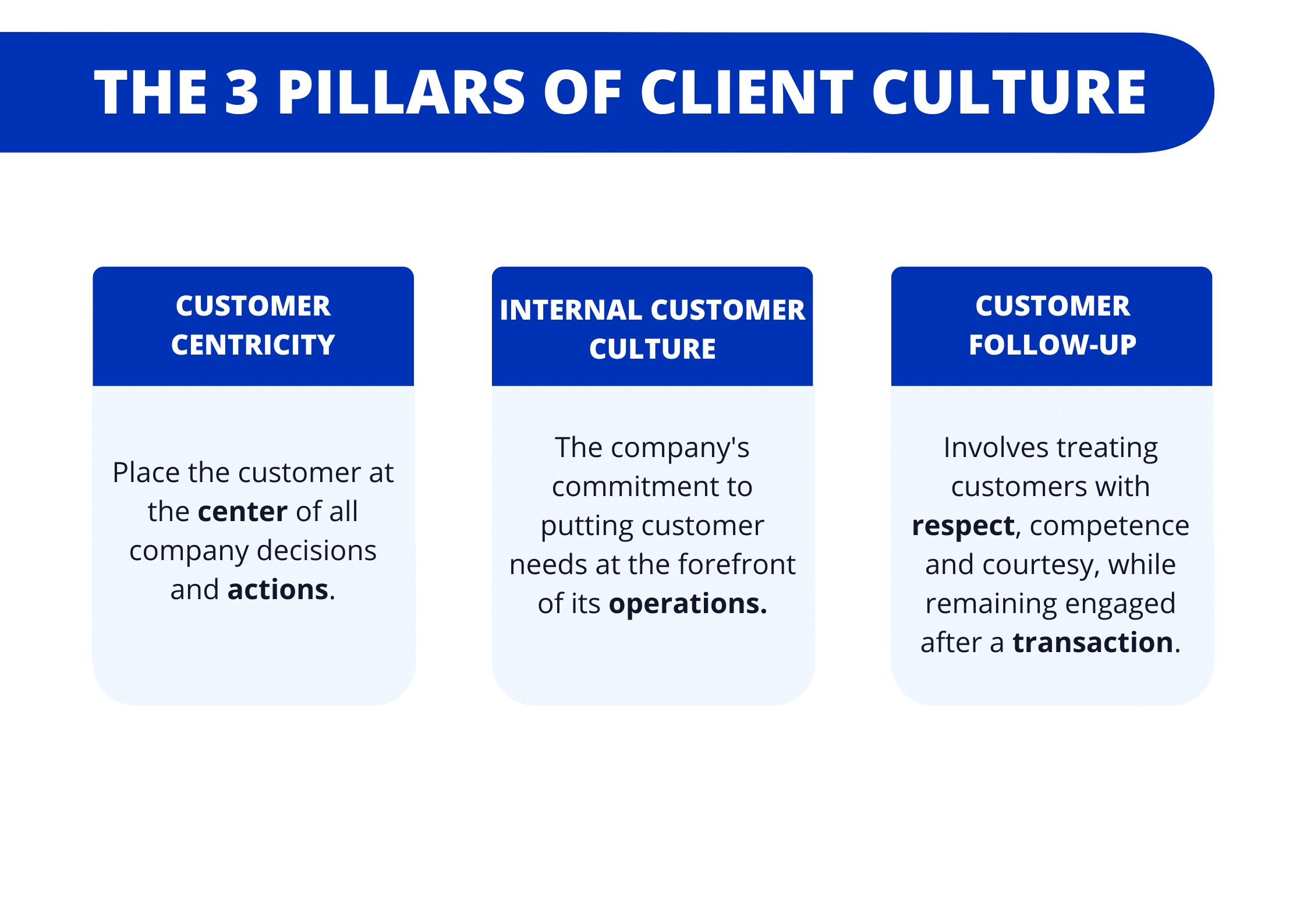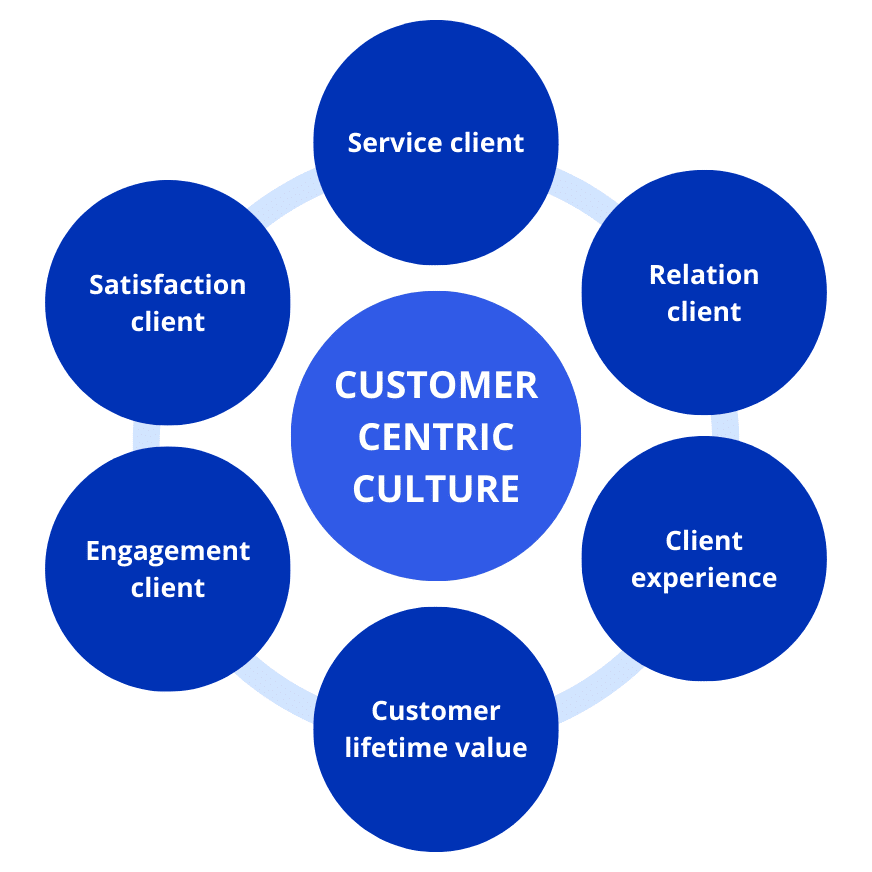A company’s operational quality is measured not only by its products or services, but also by the way it interacts with its customers. This is where customer centric culture comes in. 🎰
In this article, we’ll explain in detail its definition, its usefulness and, above all, how to cultivate it 🌴 so you never disappoint your customers and always have top customer satisfaction. ⭐️
Here’s today’s menu:
- 💬 The definition.
- 🏛️ The 3 pillars of customer culture.
- 🗝️ 6 key steps to developing it.
Here we go! 🐉
Customer centric culture: the definition
Also known as customer orientation, customer-centric culture refers to all values 🫱🏽🫲🏼, the attitudes, behaviors, practices, and standards of a company that place the satisfaction and needs of its customers first customer focus of its concerns.
The aim is to raise a company’s awareness of how important a customer is, and to create an atmosphere of trust strong mentality customer-focused. 👀
So, you wonder what this promotes? Well, here are some examples: 👇🏼
- Constantly improving customer-business interactions.
- Understanding customer expectations.
- Long-term success.
- Loyalty.
- Growth.
There is a practical way to make customer culture a reality alive. Do you know which one? 🤔
Customer-focused culture: an example
To further illustrate our point, we’ve decided to use the famous electronic commerce, I name… 🥁 Amazon.
Indeed, they have built their reputation on an exceptional customer culture, placing the needs and satisfaction of its customers at the heart of its operations. 📦
Let’s see how: 👇🏼
| Customer-focused culture at Amazon | Description |
|---|---|
| First-class customer service | 24/7 customer support, rapid customer assistance, returns, and refunds management. |
| Personalization | Product recommendations based on customers’ purchasing preferences. |
| Transparent ordering process | Clear communication on availability, delivery times and costs. |
| Prime Program | Fast delivery, entertaining content, subscriber benefits. |
| Listening to customers | Regular feedback for continuous improvement. |
| Constant innovation | Development of new technologies (Alexa) and improved logistics. |
As you may have gathered, Amazon’s customer culture is characterized by an obsession with customer satisfaction a personalization intelligent 💡, transparent communication and thank you customer, excellent customer service and, above all, continuous innovation.
The 3 pillars of customer-centric-culture
If you didn’t know, customer culture rests on three fundamental pillars that guide ⛵️ the way a company interacts with its customers, focusing on their satisfaction and loyalty.
Here’s a detailed explanation of these three pillars. 😇

1) Customer centricity
Often considered the central pillar of customer culture, it consists of placing customers at the center of all decisions and corporate actions. 👀
Basically, this means that every process, whether it’s a product, a service, or an interaction, is designed with the needs, expectations, and needs of its users in mind customer preferences.
Indeed, it goes far beyond the simple customer experience, it’s all about 🏹 creating memorable experiences that build customer loyalty and strengthen the company’s reputation. 🏢
To achieve this, companies must:
- 🟣 Listen carefully to customers: gather customer feedback and data to better understand their needs and desires.
- 🔵 Personalize the experience: adapt services, and interactions to meet individual customer needs.
- 🟣 Foster engagement: create meaningful, positive interactions at every customer touchpoint.
- 🔵 Innovate based on feedback: use customer feedback to constantly improve products and services.
- 🟣 Employee training and awareness: ensure that everyone in the company understands the importance of customer centricity by putting it into practice.
2) Internal customer culture
The second step focuses on creating an atmosphere 🌎 within the company where employees understand and share the vision of customer centricity. This involves transmitting values and behaviors that put customers first in every action. 💪🏼
To achieve this, companies must: 👇🏼
- ⚫️ Communicate with a clear vision: employees need to understand why customer satisfaction is essential and how they contribute to this mission.
- ⚫️ Training and empowering employees: training must teach employees the skills they need to deliver exceptional customer service.
- ⚫️ Focus on collaboration: encourage teams to work together to solve customer problems and improve the experience.
- ⚫️ Recognize and reward: celebrate and reward employees who embody customer culture.
As you can see, a strong in-house culture creates an environment where employees feel valued and are motivated to deliver excellent customer service. 💟
3) Professionalism and customer care
The final step in the customer culture pillar is professionalism and customer care.
Even if it’s obvious 🏖️, it’s important to treat every interaction with your customers with respect and care.
What do I mean by that? 🤔
Well, acting competently, courteously and respectfully towards customers, and maintaining an ongoing commitment, even after all the customer journey.
Here we go again with the explanations: 👇🏼
- 🔵 Train staff in effective communication: employees must be able to treat customers with respect and empathy.
- 🔵 Follow up on problems: resolve customer issues quickly and ensure they are satisfied with the resolution.
- 🔵 Gather feedback after the sale: get feedback from customers to assess their satisfaction and identify areas for improvement.
- 🔵 Communicating with gratitude: expressing appreciation to customers for their business.
Developing a consistent Customer-centric Culture helps a Business in 6 Steps
Now that you’ve understood what customer culture is, the idea is to find out how to put these steps into practice to offer a superior customer experience and promote the sustainable growth of your company. 🍀
1) Define service customer culture values
The values you define are essential, as they will guide every decision you make, every interaction and every organizational initiative. 😇
These may vary from company to company, but they generally include concepts such as customer satisfaction and a focus on continuous improvement, commitment to go beyond customer expectations, transparency, and integrity. 🖤
They will serve as a compass 🧭 to guide the behaviors and decisions of every employee. They will become the cornerstone 🗿 of your marketing strategy and corporate culture, and will help create an environment where the customer is always the center of attention.
2) Raising employee awareness and training
Once you’ve defined your values, you now need to raise awareness and train your employees. Allow me to explain.
Employees are the key players in putting customer culture into practice daily. 😇
Whether by interacting directly with customers or by making decisions that influence their experience, they’re in direct contact with them! 👀
But, where does it start, then? 🤔
Firstly, you have the active communication of customer culture values at all levels of the organization.
Basically, through meetings, presentations, or even concrete examples, you’ll be able to reinforce this understanding and explain why these values are important. 💟
In addition, training employees helps to develop skills such as:
- 1️⃣ Empathy.
- 2️⃣ Effective communication.
- 3️⃣ Problem-solving.
- 4️⃣ Managing difficult situations.
3) Collect and analyze customer feedback
Customer feedback can be collected through various channels such that:
- Satisfaction surveys.
- Online reviews.
- Social networking.
- Individual interviews.
- Direct feedback from customers.
This valuable information 💎 helps us to identify what’s working well, but also what needs improvement.
If you’re getting nothing but negative reviews, it’s time to find out why and find a solution! 😅
Indeed, it’s better to analyze 🔎 trends, recurring concerns, strengths and weaknesses.
4) Establish customer service standards
All our lives are governed by rules and standards, and well, it’s the same here!
These standards help to define expectations in terms of behavior and employee performance to customers.
What better way to illustrate our point than with a little picture? 😇
| Customer Service Standards | Concrete examples |
|---|---|
| 24-hour response | Respond to all customer requests by email or telephone within a maximum of 24 hours. For example, a customer asks a question by email, and the customer service team responds within 24 hours. |
| Courtesy and Empathy | Treat all customers with respect, courtesy and empathy, even in difficult situations. For example, a customer complains about a faulty product, and the customer service employee politely offers a sympathetic ear and alternative solutions. |
| Troubleshooting | Strive to resolve customer problems quickly and efficiently, finding appropriate solutions. For example, a customer reports a defect in a product, and the customer service team arranges a replacement or refund as quickly as possible. |
| Availability | Be available to respond to customer questions and concerns during agreed business hours. For example, customer service offers live chat support during office hours. |
| Returns follow-up | Proactively follow up on product returns and customer complaints to ensure that their experience is satisfactorily resolved. For example, following the return of a faulty product, customer service contacts the customer to confirm receipt and guarantee a refund. |
5) Communicate internally
This penultimate step involves sharing actively customer culture values with all members of the organization, from managers to employees. And remember this: it must be clear, consistent, and engaging! 🩵
In addition to improving your employer branding it means actively sharing the values of customer culture with all employees’ organization members from executives to front-line employees.
This communication must be clear, coherent, and engaging.
6) Measure customer satisfaction
Last but not least, it’s time to measure customer satisfaction!
But how? 🤔
You can also use performance indicators such as the Net Promoter Score (NPS), the satisfaction surveys or other company-specific indicators to assess how customers perceive the experience they have with you. 👀
This will enable you to make clear decisions to improve your customer service.
A little extra: if the results are positive, you can motivate your employees and show them that you care about the positive impact of their work. 🥰

How about a recap?
In short, if you want to develop a strong customer culture: 💪🏼
- Define clear values.
- Train employees.
- Listening to customers.
- Set service standards.
- Communicate well internally.
- Measure customer satisfaction.
This whole culture puts customers at the heart 💙 of the company, enhancing their experience and fostering their loyalty.
Frequently asked question: “Building a customer centric culture”
Did you think we were done? Not quite, we have a few more resources to share with you. 😇
How does Daniel Ray define customer centric culture?
For Daniel Ray, customer culture is “a set of attitudes and behaviors for employees that reflect a genuine concern for the customer’s satisfaction. customer satisfaction”.
How do you foster customer-focused culture?
To drive customer-centric culture within your company, here are 5 key tips: 🔑
- 🟣 Committed leadership.
- 🔵 Continuing education.
- 🟣 Data collection and use.
- 🔵 Rewards and recognition.
- 🟣 Continuous internal communication.
How do you achieve customer orientation?
Customer orientation is the same principle as customer centricity, i.e., you put the customer at the center of all your company’s activities and decisions, in your marketing strategy.
- Define clear values.
- Train employees.
- Listen to customers.
- Set service standards.
- Communicate well internally.
- Measure customer satisfaction.
That’s the end of this article on customer centric culture. See you soon! 🐲









